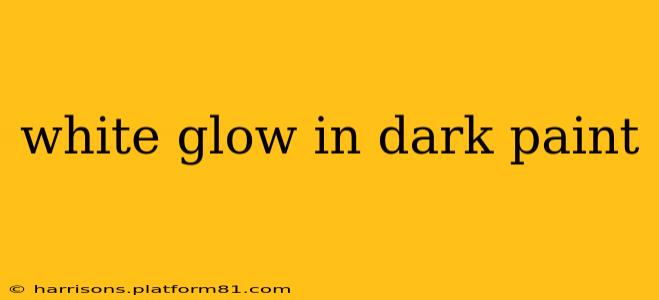Glow-in-the-dark paint has become increasingly popular for a wide range of creative and practical applications. While many associate glow-in-the-dark with vibrant colors, white glow-in-the-dark paint offers a unique and often subtle luminescence that's perfect for specific projects. This guide delves into everything you need to know about white glow-in-the-dark paint, covering its properties, applications, and considerations for optimal use.
What is White Glow-in-the-Dark Paint?
White glow-in-the-dark paint, unlike its brighter counterparts, emits a soft, ethereal glow rather than a bold, intense light. This muted luminosity makes it ideal for projects where a subtle, ambient light is desired, rather than a flashy, attention-grabbing effect. The "glow" is achieved through the use of phosphorescent pigments, which absorb and store energy from light sources (like sunlight or UV light) and then slowly release it as light over time. The longer the paint is exposed to a light source, the brighter and longer it will glow.
How Does White Glow-in-the-Dark Paint Work?
The magic behind glow-in-the-dark paint lies in its phosphorescent pigments. These pigments contain materials like strontium aluminate, which absorb energy from light and then release it slowly in the form of light. This process is called phosphorescence. The white color is achieved by using a base that doesn't significantly affect the phosphorescent material's ability to absorb and release light.
What are the Different Types of White Glow-in-the-Dark Paint?
While the core principle remains the same, variations exist in the formulation of white glow-in-the-dark paints. These differences can affect factors like glow intensity, duration, and application. Some paints are designed for specific surfaces (wood, canvas, etc.), while others offer different levels of viscosity for various application techniques. It's important to read the product specifications before purchasing to ensure you choose the right type for your project.
How Long Does White Glow-in-the-Dark Paint Glow?
The duration of the glow varies depending on several factors including the quality of the paint, the intensity and duration of the charging light source, and environmental factors like temperature. Generally, high-quality white glow-in-the-dark paints can glow for several hours after being fully charged, gradually diminishing in brightness over time.
How long does it take to charge white glow in the dark paint?
Charging time also depends on the light source. Direct sunlight will generally charge the paint faster and more effectively than indoor lighting. Expect charging times ranging from a few minutes under intense UV light to several hours under less intense light sources.
How bright does white glow in the dark paint glow?
The brightness of white glow-in-the-dark paint is significantly less intense compared to brighter glow-in-the-dark colors. The glow is more of a subtle luminescence, creating a soft, almost ethereal effect.
What surfaces can white glow in the dark paint be applied to?
White glow-in-the-dark paint can be applied to a variety of surfaces, including wood, canvas, metal, plaster, and some plastics. However, it's crucial to ensure the surface is clean, dry, and properly prepared before application for optimal adhesion and glow. Always test on a small, inconspicuous area first.
Is white glow in the dark paint toxic?
Reputable brands of glow-in-the-dark paint generally utilize non-toxic materials. However, always check the manufacturer's safety data sheet (SDS) for specific information on potential hazards and safety precautions. Proper ventilation during application is always recommended.
What are some creative uses for white glow-in-the-dark paint?
The subtle glow of white glow-in-the-dark paint makes it perfect for a range of creative projects, including:
- Stars on a ceiling: Create a calming, celestial atmosphere in a bedroom.
- Accentuating details: Highlight specific features of artwork or furniture.
- Creating unique lighting effects: Use it in conjunction with other lighting sources for a layered effect.
- Nightlights: Paint small objects or shapes for a gentle nightlight.
By carefully considering these factors and selecting the right paint for your project, you can achieve stunning and unique results with white glow-in-the-dark paint. Remember to always prioritize safety and follow the manufacturer's instructions for optimal results and longevity.
